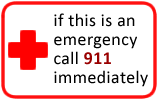Sinus Pain or Congestion
Sinus Pain or Congestion
Does this describe your child's symptoms? |
Definition
Symptoms
Causes of Sinus Congestion
Treatment of Sinusitis
Color of Nasal Dischargewith Colds
Return to School
|
If not, see these topics
|
When to Call Your Doctor |
Call 911 Now (your child may need an ambulance) If |
|
|
|
Call Your Doctor Now (night or day) If |
|
|
|
Call Your Doctor Within 24 Hours (between 9 am and 4 pm) If |
|
|
|
Call Your Doctor During Weekday Office Hours If |
|
|
|
Parent Care at Home If |
|
|
HOME CARE ADVICE FOR SINUS CONGESTION |
Reassurance:
Sinus congestion is a normal part of a cold.
Usually, home treatment with nasal washes can prevent an actual bacterial sinus infection.
Antibiotics are not helpful for the sinus congestion that occurs with colds.
Nasal Washes to Open a Blocked Nose:
Use saline nose drops or spray to loosen up the dried mucus. If not available, can use warm tap water. Teens can just splash warm tap water in the nose and then blow.
STEP 1: Instill 3 drops per nostril.
STEP 2: Blow each nostril separately while closing off the other nostril. Then do other side.
STEP 3: Repeat nose drops and blowing until the discharge is clear.
Frequency: Do nasal washes whenever your child can't breathe through the nose.
Saline nasal sprays can be purchased without a prescription
Saline nose drops can also be made: add 1/2 tsp (2 ml) of table salt to 1 cup (8 ounces or 240 ml) of warm water.
Reason for nose drops: suction or nose blowing alone can't remove dried or sticky mucus.
Another option: use a warm shower to loosen mucus. Breathe in the moist air, then blow each nostril.
Fluids: Encourage your child to drink adequate fluids to prevent dehydration. This will also thin out the nasal secretions and loosen the phlegm in the airway.
Humidifier: If the air in your home is dry, run a humidifier.
Decongestant Nose Spray (no prescription needed):
Use this only if the sinus still seems blocked up after nasal washes AND age 12 years or older. Use the long-acting type (e.g., Afrin).
Dosage: 1 spray on each side 2 times/day.
Always clean out the nose before using.
Use routinely for 2 days, thereafter only for symptoms.
Don't use for more than 5 days (Reason: rebound congestion).
Pain Medicine: Give acetaminophen (e.g., Tylenol) or ibuprofen for pain relief. The application of a cold pack or ice in a wet washcloth over the sinus for 20 minutes may also help.
Antihistamines: Give oral antihistamines (such as Benadryl) only if the child also has nasal allergies.(No prescription needed). See Dosage table.
Expected Course:
With treatment, the viral sinus congestion usually resolves in 7 to 14 days.
The main complication occurs if bacteria multiply within the blocked sinus (bacterial sinusitis). This leads to a fever and increased pain. It needs antibiotics.
Contagiousness: Sinus infections are not contagious. If the sinus pain or congestion is associated with a cold or other infection, your child can return to school after the fever is gone and your child feels well enough to participate in normal activities.
Call Your Doctor If:
Sinus pain persists for over 1 day after starting treatment
Sinus congestion persists for over 2 weeks
Sinus pain present and fever occurs
Your child becomes worse
And remember, contact your doctor if your child develops any of the "Call Your Doctor" symptoms.
Updated:
March 22, 2017



